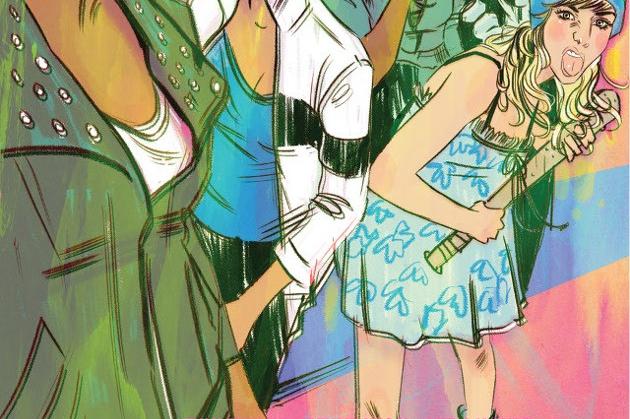Curb Stomp #1
The year was 1981. It was a year before I was born. It was just shy of a decade before the characters of Curb Stomp were born. A fresh-faced Henry Rollins had just joined upstart hardcore punk rock band Black Flag. Their first LP release, Damaged, was kicked off by a quick-paced track called Rise Above. An anthem for the underdog, for the oppressed, Rise Above touts the core tenants of punk rock – being yourself, having a good time, and resisting authority.
That was a great story, but what the hell does it have to do with Curb Stomp? Ryan Ferrier brings this punk rock ethos to the pages of Curb Stomp, showing a strong group of women resisting the advances of the dark city into their suburb, as well as the encroachment of rival gangs into their territory. This is a story we’ve seen before, a group of friends-turned-family protecting their own against the slowly deteriorating backdrop of organized crime and corruption. Ferrier capably makes the characters his own, balancing their diversity with a powerful sense of union and desire to protect their home. This brings legitimacy to their gang, The Fever, which invests us in their well-being. Ferrier doesn’t allow the reader to get comfortable, though, as the subject matter quickly spirals into a dark place. The noir-ish dialogue and narration fits well with these characters, bringing just enough cliché to keep the reader entertained without seeming stale. The titular action, the Curb Stomp, makes its appearance towards the end of the book, forwarding the plot and giving us a good idea of where to expect this story to go. Things do not go our hero’s way. I have a feeling this may not be a story where the good guys win easily and everyone has a party afterwards.
Devaki Neogi brings the style of a somewhat edgier Mike Allred to this story, and Neil Lalonde’s muted tones with splashes of color really bring the mood to life. This is a beautiful book to look at, and the myriad of influences don’t overwhelm the reader, which could be easy to do. There are elements of noir and post-apocalyptic story telling here, not to mention the punk rock club scene. The art team deftly manages to transition between the set pieces keeping a sense of cohesion. More than the writing, the art brought me back to this story for a second go around. The visual story telling is top notch.
I’m looking forward to seeing what Ferrier, Neogi, and Lalonde bring to the table with this limited series. It hit a lot of great notes while avoiding several pitfalls. There is a level of unpredictability that I was not expecting to encounter with this story. I hope they continue to play with those ideas and embrace the punk rock ethos.
---------------------------
Matthew can be found on Twitter as @mahargen, where he spends most of his time moaning about the way punk rock used to be, even though it may or may not have been dead before he was even born.
That was a great story, but what the hell does it have to do with Curb Stomp? Ryan Ferrier brings this punk rock ethos to the pages of Curb Stomp, showing a strong group of women resisting the advances of the dark city into their suburb, as well as the encroachment of rival gangs into their territory. This is a story we’ve seen before, a group of friends-turned-family protecting their own against the slowly deteriorating backdrop of organized crime and corruption. Ferrier capably makes the characters his own, balancing their diversity with a powerful sense of union and desire to protect their home. This brings legitimacy to their gang, The Fever, which invests us in their well-being. Ferrier doesn’t allow the reader to get comfortable, though, as the subject matter quickly spirals into a dark place. The noir-ish dialogue and narration fits well with these characters, bringing just enough cliché to keep the reader entertained without seeming stale. The titular action, the Curb Stomp, makes its appearance towards the end of the book, forwarding the plot and giving us a good idea of where to expect this story to go. Things do not go our hero’s way. I have a feeling this may not be a story where the good guys win easily and everyone has a party afterwards.
Devaki Neogi brings the style of a somewhat edgier Mike Allred to this story, and Neil Lalonde’s muted tones with splashes of color really bring the mood to life. This is a beautiful book to look at, and the myriad of influences don’t overwhelm the reader, which could be easy to do. There are elements of noir and post-apocalyptic story telling here, not to mention the punk rock club scene. The art team deftly manages to transition between the set pieces keeping a sense of cohesion. More than the writing, the art brought me back to this story for a second go around. The visual story telling is top notch.
I’m looking forward to seeing what Ferrier, Neogi, and Lalonde bring to the table with this limited series. It hit a lot of great notes while avoiding several pitfalls. There is a level of unpredictability that I was not expecting to encounter with this story. I hope they continue to play with those ideas and embrace the punk rock ethos.
---------------------------
Matthew can be found on Twitter as @mahargen, where he spends most of his time moaning about the way punk rock used to be, even though it may or may not have been dead before he was even born.





